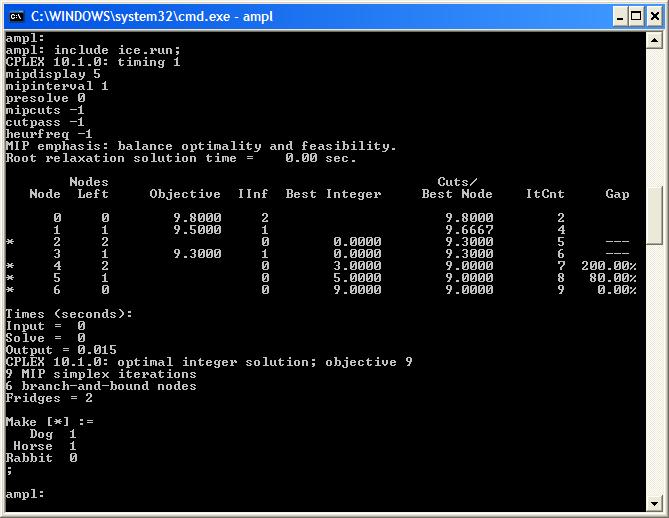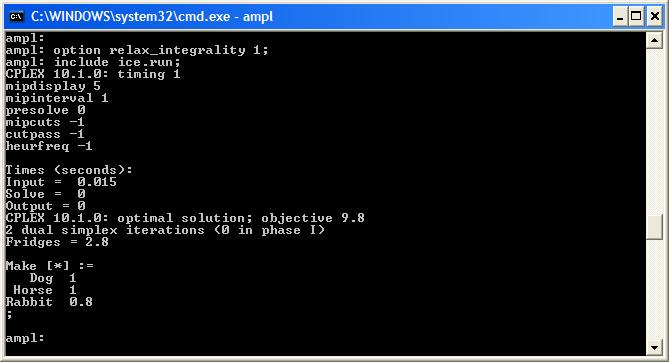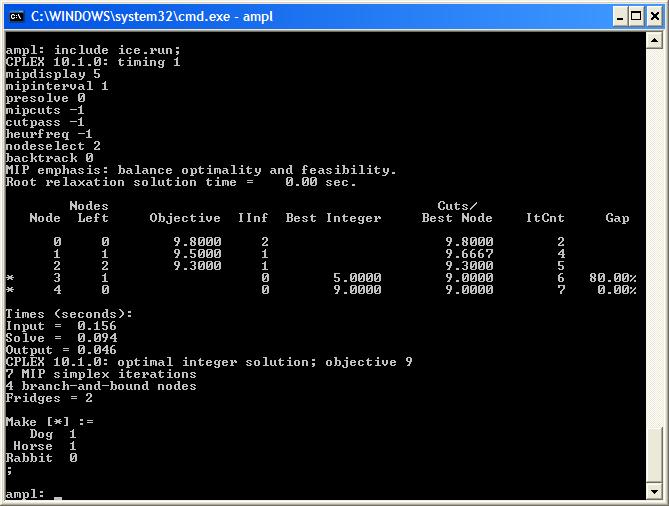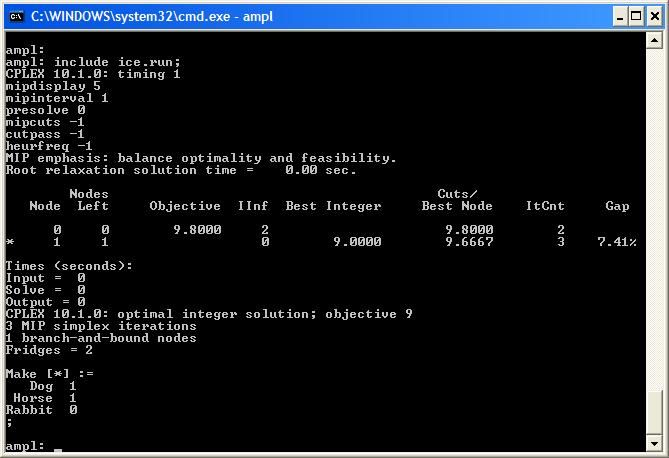
Difference: IntegerProgrammingWithAMPL (3 vs. 4)
Revision 42008-05-11 - MichaelOSullivan
| Line: 1 to 1 | ||||||||
|---|---|---|---|---|---|---|---|---|
Integer Programming with AMPL | ||||||||
| Line: 8 to 8 | ||||||||
| To demonstrate the techniques we can use to control integer programming we will look at a simple integer programming problem: | ||||||||
| Changed: | ||||||||
| < < | Jim has three requests for frozen ice sculptures, his commission is $1000, $7000 and $5000 respectively. He must hire a refrigeration unit to transport each one. The units cost $4000 each. The sculptures will be transported on a truck with capacity 1.7 tonnes and he estimates the total weight of each sculpture (including the refrigeration unit) to be 1 tonne, half a tonne and a quarter of a tonne respectively. Jim must decide which sculptures to make to maximize his profit. | |||||||
| > > | Jim has three requests for frozen ice sculptures, his commission is $10000, $7000 and $5000 respectively. He must hire a refrigeration unit to transport each one. The units cost $4000 each. The sculptures will be transported on a truck with capacity 1.7 tonnes and he estimates the total weight of each sculpture (including the refrigeration unit) to be 1 tonne, half a tonne and a quarter of a tonne respectively. Jim must decide which sculptures to make to maximize his profit. | |||||||
| Changed: | ||||||||
| < < | The AMPL model and data files, ice.mod and ice.dat respectively, are attached. | |||||||
| > > | The AMPL model and data files, ice.mod and ice.dat respectively, are attached. | |||||||
| Solving this problem with AMPL and CPLEX is very fast (it is only a small problem): | ||||||||
| Changed: | ||||||||
| < < |  | |||||||
| > > |  | |||||||
| However, sometimes all the technology behind CPLEX does not work so well and we need to control the branch-and-bound tree. We will use this small example problem to demonstrate the effect of changing the default behaviour of CPLEX. First, let's remove all the CPLEX technology and re-solve our problem using an AMPL script: | ||||||||
| Changed: | ||||||||
| < < |
reset;
model ice.mod;
data ice.dat;
option solver cplex;
option presolve 0;
option cplex_options ('timing 1 mipdisplay 5 mipinterval 1' &
'presolve 0 mipcuts -1 cutpass -1 ' &
'heurfreq -1');
solve;
display Fridges, Make;
| |||||||
| > > | reset; model ice.mod; data ice.dat; option solver cplex; option presolve 0; option cplex_options ('timing 1 mipdisplay 5 mipinterval 1' & 'presolve 0 mipcuts -1 cutpass -1 ' & 'heurfreq -1'); solve; display Fridges, Make; | |||||||
| With all CPLEXs "bells and whistles" removed we get a slightly larger branch-and-bound tree: | ||||||||
| Changed: | ||||||||
| < < |  | |||||||
| > > |  | |||||||
| Let's look at ways to reduce the size of this branch-and-bound tree. | ||||||||
| Line: 51 to 33 | ||||||||
| If we look at the variables we can see where our solution is fractional: | ||||||||
| Changed: | ||||||||
| < < |  | |||||||
| > > |  | |||||||
| Changed: | ||||||||
| < < | As you can see we are using 2.8 fridge units for our 2.8 sculptures. Also, if we check the TotalWeight constraint (display TotalWeight.body;) we can see that the truck is at its weight limit. | |||||||
| > > | As you can see we are using 2.8 fridge units for our 2.8 sculptures. Also, if we check the TotalWeight constraint (display TotalWeight.body;) we can see that the truck is at its weight limit. | |||||||
It looks likely that we should only use 2 fridges. We can create some new suffixes to experiment with our hypothesis.
Priorities, Searching and DirectionsAMPL and CPLEX allow you to define a priority for your integer variables. This means that if more than one integer variable is fractional in a solution, CPLEX will branch on the highest priority variable first. Let's add the priority suffix to our run file (before solving): | ||||||||
| Changed: | ||||||||
| < < | suffix priority IN, integer, >= 0, <= 9999;(now we can assign variables priorities ranging from 0 - least - to 9999 - most). Let's give the Fridges variable a priority of 100 and the Make variables a priority of 0:
let Fridges.priority := 100;
let {s in SCULPTURES} Make[s].priority := 0;
| |||||||
| > > | suffix priority IN, integer, >= 0, <= 9999;(now we can assign variables priorities ranging from 0 - least - to 9999 - most). Let's give the Fridges variable a priority of 100 and the Make variables a priority of 0: let Fridges.priority := 100; let {s in SCULPTURES} Make[s].priority := 0; | |||||||
| Changed: | ||||||||
| < < |  | |||||||
| > > |  | |||||||
The branch-and-bound tree appears unchanged, so perhaps CPLEX had already branched on Fridges early in the branch-and-bound tree. However, we can try a breadth-first search of the tree, since this will try different values for Fridges before performing branching on other variables. Setting nodeselect to 2 (best estimate) and backtrack to 0 makes CPLEX perform a search very close to breadth-first (see The AMPL CPLEX User Guide | ||||||||
| Changed: | ||||||||
| < < |
option cplex_options ('timing 1 mipdisplay 5 mipinterval 1 ' &
'presolve 0 mipcuts -1 cutpass -1 ' &
'heurfreq -1 ' &
'nodeselect 2 backtrack 0');
| |||||||
| > > | option cplex_options ('timing 1 mipdisplay 5 mipinterval 1 ' & 'presolve 0 mipcuts -1 cutpass -1 ' & 'heurfreq -1 ' & 'nodeselect 2 backtrack 0'); | |||||||
| Changed: | ||||||||
| < < |  | |||||||
| > > |  | |||||||
| Now the tree has been fathomed earlier (it only has 4 nodes instead of 6). However, we are not sure if CPLEX branched down to 2 fridges first (our hypothetical optimum). To control the direction of the branches we can create a new suffix for the direction we should branch on each variable (-1 for down, 0 for no preference, 1 for up). | ||||||||
| Changed: | ||||||||
| < < | suffix direction IN, integer, >= -1, <= 1; | |||||||
| > > | suffix direction IN, integer, >= -1, <= 1; | |||||||
We can force a down branch first on Fridges: | ||||||||
| Changed: | ||||||||
| < < | let Fridges.direction := -1; | |||||||
| > > | let Fridges.direction := -1; | |||||||
| Changed: | ||||||||
| < < |  | |||||||
| > > |  | |||||||
| This doesn't seem to have decreased the size of the branch-and-bound tree. Let's try one more thing. We have given CPLEX a good branch to try first, but we have not carefully considered what to do next. Let's remove the breadth-first search option and let CPLEX decide how to proceed: | ||||||||
| Changed: | ||||||||
| < < |
reset;
model ice.mod;
data ice.dat;
option solver cplex;
option presolve 0;
option cplex_options ('timing 1 mipdisplay 5 mipinterval 1' &
'presolve 0 mipcuts -1 cutpass -1 ' &
'heurfreq -1');
suffix priority IN, integer, >= 0, <= 9999;
suffix direction IN, integer, >= -1, <= 1;
let Fridges.priority := 100;
let {s in SCULPTURES} Make[s].priority := 0;
let Fridges.direction := -1;
solve;
display Fridges, Make;
| |||||||
| > > | reset; model ice.mod; data ice.dat; option solver cplex; option presolve 0; option cplex_options ('timing 1 mipdisplay 5 mipinterval 1' & 'presolve 0 mipcuts -1 cutpass -1 ' & 'heurfreq -1'); suffix priority IN, integer, >= 0, <= 9999; suffix direction IN, integer, >= -1, <= 1; let Fridges.priority := 100; let {s in SCULPTURES} Make[s].priority := 0; let Fridges.direction := -1; solve; display Fridges, Make; | |||||||
| Changed: | ||||||||
| < < |  | |||||||
| > > |  | |||||||
| Now we have reduced our branch-and-bound tree to a single node by making a good choice about our first variable branch and letting CPLEX proceed from there. | ||||||||
View topic | History: r5 < r4 < r3 < r2 | More topic actions...
Ideas, requests, problems regarding TWiki? Send feedback